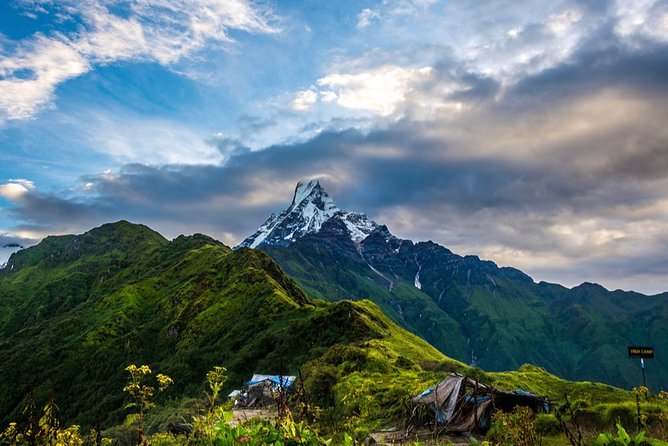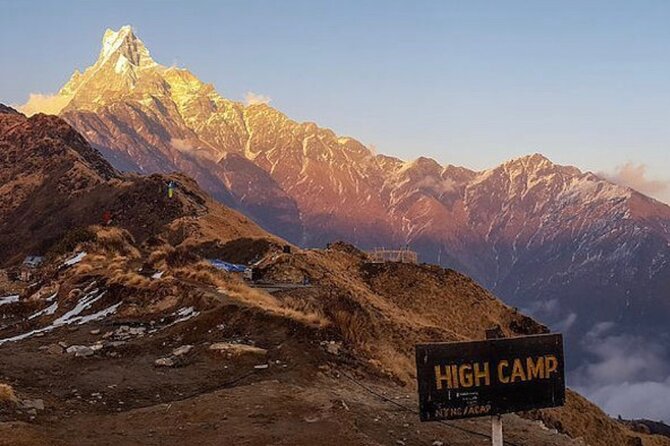Mardi Himal Trek (4500 Meters)
Have you ever wondered what it would be like to trek amidst the towering peaks of the Himalayas, reaching heights of 4500 meters?
The Mardi Himal Trek offers a glimpse into this captivating world, where every step unveils a new vista and every turn presents a fresh perspective.
The allure of this journey lies not only in its challenging terrain but also in the promise of unforgettable encounters with nature’s grandeur.
As travelers venture forth, they are met with an adventure that promises to leave them in awe of the majestic landscapes and the raw beauty of the Himalayas.
Key Points

- Moderate difficulty trek suitable for novices and experienced trekkers
- Immerse in local culture with Gurung and Magar communities
- Witness traditional village life and colorful festivals
- Blend of natural beauty, cultural richness, and safety precautions
Trek Overview
Embark on the Mardi Himal Trek at 4500 meters for an exhilarating journey through the breathtaking landscapes of the Himalayas.
The trek offers a moderate level of difficulty, making it suitable for both novice and experienced trekkers. It provides an excellent opportunity to take in the rich local culture of the region, interacting with the friendly Gurung and Magar communities along the way.
Trekkers will have the chance to witness traditional village life, colorful festivals, and unique customs, adding a cultural dimension to the adventure.
The Mardi Himal Trek not only challenges one’s physical abilities but also provides a profound cultural experience, making it a well-rounded expedition for those seeking both adventure and culture.
Best Time to Go

For those considering the Mardi Himal Trek, understanding the best time to go is key to maximizing the experience amidst the Himalayan landscapes. The ideal periods to embark on this adventure are during the pre-monsoon (late February to April) and post-monsoon (September to November) seasons.
These times offer stable weather patterns with clear skies, making for excellent visibility of the stunning surroundings. On top of that, during these months, the chances of encountering altitude sickness are reduced due to favorable trail conditions and moderate temperatures.
It’s advisable to secure travel insurance before starting the trek to ensure coverage for any unforeseen circumstances that may arise along the trail, providing peace of mind while exploring this breathtaking region.
Packing Essentials
Ensuring you pack the essential items for your Mardi Himal Trek at 4500 meters is crucial for a safe and enjoyable journey through the stunning Himalayan landscapes.
When it comes to gear recommendations, sturdy and waterproof hiking boots, a lightweight and breathable backpack, warm layers of clothing, a quality sleeping bag suitable for cold temperatures, a durable tent, and trekking poles are must-haves.
Plus, consider packing sunscreen, sunglasses, a hat, a first aid kit, water purification tablets, and high-energy snacks.
Weather considerations are vital, as temperatures can vary greatly, so pack accordingly with layers that can be easily added or removed. Be prepared for sudden weather changes by having a waterproof jacket and pants on hand.
Route Highlights
As you traverse the Mardi Himal Trek at 4500 meters, be prepared to encounter a myriad of awe-inspiring highlights along the route.
The journey offers fantastic photo spots where you can capture the breathtaking vistas of the Himalayas.
Don’t miss the chance to indulge in the delicious local cuisine, a perfect way to learn about the culture of the region.
Keep your eyes peeled for wildlife sightings; you might spot some exotic species native to the area.
Plus, the trek provides ample opportunities for unique cultural experiences, interacting with local communities, and learning about their traditions.
Each step along the route promises a blend of natural beauty and cultural richness that will make your Mardi Himal adventure truly unforgettable.
Acclimatization Tips
To acclimatize effectively during the Mardi Himal Trek at 4500 meters, hikers should gradually ascend in altitude, allowing their bodies to adjust to the decreasing oxygen levels. Altitude sickness can be a concern at higher elevations, so it’s crucial to hydrate adequately.
Hydration strategies like drinking plenty of water and avoiding alcohol can help prevent dehydration, a common risk factor for altitude sickness. Plus, consuming electrolyte-rich fluids or sports drinks can aid in maintaining the body’s fluid balance.
It’s essential to listen to one’s body, recognizing symptoms like headaches, nausea, or fatigue, which could indicate altitude sickness. Proper acclimatization and hydration are key components to a safe and enjoyable trek in the stunning Mardi Himal region.
Safety Precautions
During the Mardi Himal Trek at 4500 meters, hikers should prioritize safety precautions to ensure a secure and enjoyable journey in the high-altitude environment. One of the most critical aspects of safety during this trek is being prepared for emergency procedures and conducting a thorough risk assessment before embarking on the journey. Altitude sickness is a common concern at high altitudes, so hikers must be aware of the symptoms and know how to manage them. Carrying a well-equipped first aid kit and knowing how to administer basic first aid can make a significant difference in emergencies. Below is a table summarizing key safety precautions for the Mardi Himal Trek:
| Safety Precautions | Details |
|---|---|
| Emergency procedures | Be prepared, know emergency contact numbers, have a plan in place. |
| Risk assessment | Identify potential risks, plan accordingly, stay informed. |
| Altitude sickness | Recognize symptoms, descend if necessary, stay hydrated. |
| First aid | Carry a first aid kit, know how to treat common trekking injuries. |
Common questions
Are Permits Required for the Mardi Himal Trek (4500 Meters)?
Permits are required for certain treks to regulate visitor numbers and ensure safety. Altitude acclimatization is crucial to prevent altitude sickness at higher elevations. It’s always wise to obtain the necessary permits and follow guidelines diligently.
What Are the Bathroom Facilities Like Along the Trekking Route?
Hygiene practices along the trekking route are crucial. Proper waste disposal methods are in place to maintain cleanliness. Bathrooms vary from basic pit toilets to more modern facilities at some stops, ensuring hikers have options.
Is It Possible to Rent Trekking Gear at the Starting Point of the Trek?
Yes, it’s possible to rent trekking gear at the starting point of the trek. Many trekking shops offer a variety of equipment for rent, ensuring hikers have access to necessary items for a safe and enjoyable journey.
Are There Any Medical Facilities or Emergency Services Available Along the Trekking Route?
Medical facilities and emergency services are essential along trekking routes. They provide crucial aid in case of injuries or emergencies. Trekking organizations often have protocols in place to ensure the safety and well-being of trekkers throughout their journey.
Are There Any Restrictions or Guidelines for Interacting With the Local Communities During the Trek?
When trekking, it’s important to respect local customs and show cultural sensitivity. Interacting with local communities should be done with courtesy and an open mind. Understanding and following any guidelines provided will help create positive interactions along the journey.
Last Words
To sum it up, the Mardi Himal Trek offers a thrilling adventure through the majestic Himalayas, with stunning landscapes and panoramic views that will leave travelers in awe.
With the right preparation, including packing essentials and acclimatization tips, adventurers can safely navigate this challenging yet rewarding terrain.
Whether you’re a nature enthusiast or a thrill-seeker, joining this expedition promises an unforgettable experience in the pristine beauty of the Nepalese mountains.